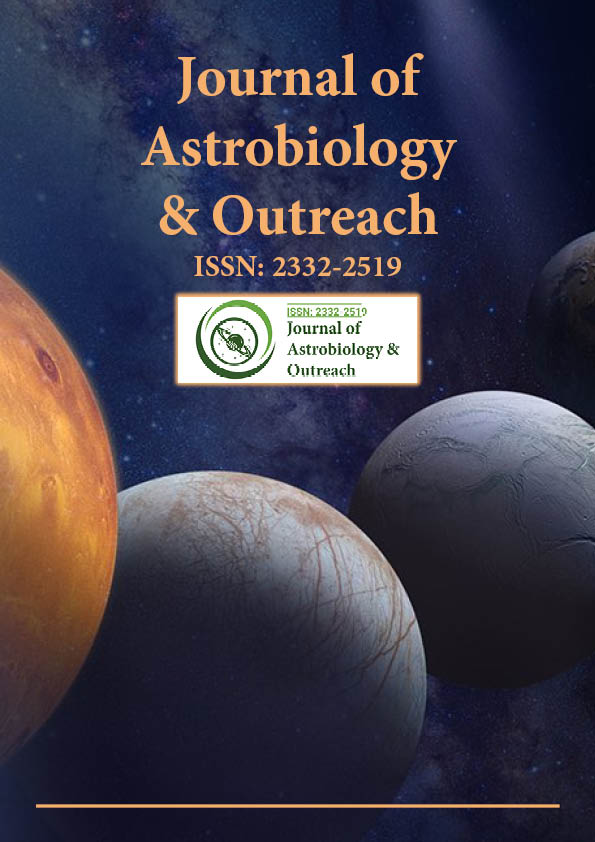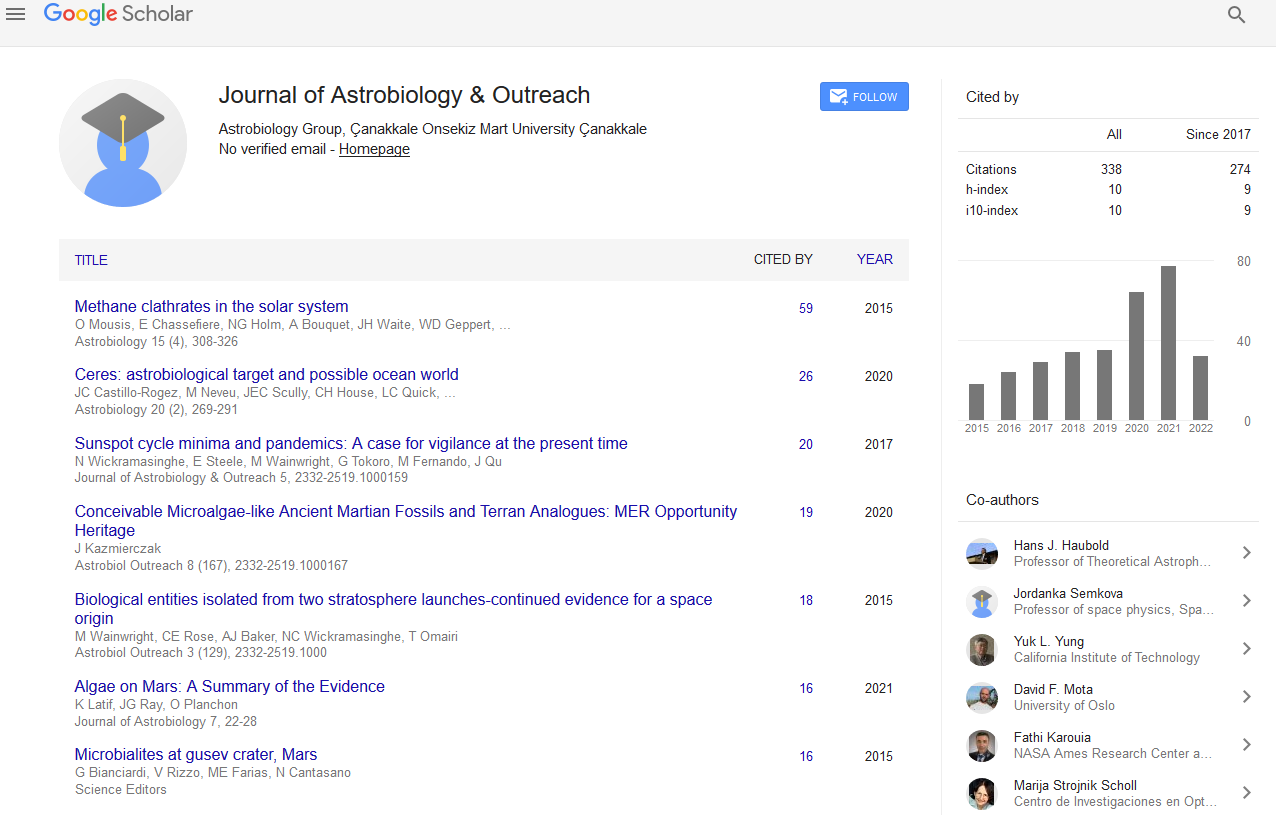Indexed In
- Open J Gate
- Academic Keys
- JournalTOCs
- RefSeek
- Hamdard University
- EBSCO A-Z
- OCLC- WorldCat
- Google Scholar
Useful Links
Share This Page
Journal Flyer

Open Access Journals
- Agri and Aquaculture
- Biochemistry
- Bioinformatics & Systems Biology
- Business & Management
- Chemistry
- Clinical Sciences
- Engineering
- Food & Nutrition
- General Science
- Genetics & Molecular Biology
- Immunology & Microbiology
- Medical Sciences
- Neuroscience & Psychology
- Nursing & Health Care
- Pharmaceutical Sciences
Commentary - (2024) Volume 12, Issue 3
GAGG-SiPM Compton Cameras: Advancing Gamma-Ray Astronomy and High-Energy Imaging
Emma White*Received: 30-Aug-2024, Manuscript No. JAO-24-27911; Editor assigned: 02-Sep-2024, Pre QC No. JAO-24-27911 (PQ); Reviewed: 16-Sep-2024, QC No. JAO-24-27911; Revised: 23-Sep-2024, Manuscript No. JAO-24-27911 (R); Published: 30-Sep-2024, DOI: 10.35248/2332-2519.24.12.352
Description
Gamma-ray astronomy is a remarkable field that enables the study of high-energy phenomena in the universe. The ability to detect and analyze gamma rays with precision is essential for understanding astrophysical processes such as black hole activity, neutron star collisions and supernova explosions. To achieve this, advanced detection technologies are essential and Compton cameras represent a highly effective approach for imaging gamma rays. A recent focus in this area is the evaluation of systems based on Gadolinium Aluminum Gallium Garnet (GAGG) scintillators coupled with Silicon Photomultipliers (SiPMs), offering significant advancements in gamma-ray detection and imaging.
GAGG scintillators are increasingly popular due to their exceptional properties, including high light yield, excellent energy resolution and strongness against environmental conditions like moisture. These attributes make them suitable for gamma-ray detection across a wide energy spectrum. When paired with SiPMs, which are compact, operate at low voltage and exhibit high sensitivity to low light levels, the resulting system becomes a powerful tool for gamma-ray imaging. The combination of GAGG scintillators and SiPMs in Compton camera configurations is particularly potential because of their combined ability to provide detailed and accurate information about the origin and energy of incoming gamma rays.
Compton cameras work by reconstructing gamma-ray trajectories based on the Compton scattering process. In this process, an incoming gamma-ray photon scatters off a target and its energy and scattering angle are measured. These measurements allow for the determination of the photon's original direction, enabling the imaging of gamma-ray sources. The combination of GAGG and SiPM technologies improves the performance of these cameras, providing improved resolution, sensitivity and adaptability for various applications.
Performance evaluations of GAGG-SiPM-based Compton cameras have demonstrated their potential in gamma-ray astronomy. For example, these systems provide excellent energy resolution, which is critical for distinguishing between gammaray sources and for precise spectral analysis. They also exhibit high detection efficiency, ensuring that even weak gamma-ray signals from distant astrophysical sources can be captured and analyzed. Additionally, their compact and lightweight design makes them suitable for deployment in space-based telescopes, where size and weight constraints are significant considerations.
One of the notable advantages of GAGG-SiPM systems is their capability to function effectively in various energy ranges. This versatility is essential for gamma-ray astronomy, as different astrophysical phenomena emit gamma rays at different energies. For example, lower-energy gamma rays might originate from radioactive decay processes, while higher-energy emissions could be associated with particle acceleration near black holes or neutron stars. The ability of GAGG-SiPM Compton cameras to adapt to these energy variations improves their utility in observing a wide range of cosmic events.
The strongness and reliability of GAGG-SiPM systems also make them suitable for use in challenging environments, such as space missions. The non-hygroscopic nature of GAGG scintillators ensures that they remain stable and functional in the vacuum of space, while the low power requirements of SiPMs make them ideal for energy-limited platforms. These characteristics enable long-term observations of gamma-ray sources, contributing to continuous monitoring and data collection for astrophysical research.
Another critical aspect of GAGG-SiPM-based Compton cameras is their ability to support multi-modal imaging techniques. By combining these systems with other detectors or imaging technologies, researchers can combine data from different wavelengths or particle interactions to gain a more comprehensive understanding of astrophysical phenomena. For example, gamma-ray observations can be paired with X-ray or optical imaging to study the same event from multiple perspectives, providing valuable insights into its underlying mechanisms.
The potential of GAGG-SiPM-based Compton cameras extends beyond gamma-ray astronomy. These systems have applications in fields such as medical imaging, nuclear security and environmental monitoring, where precise detection of highenergy photons is required. In medical imaging, for example, they could be used to improve the accuracy of Positron Emission Tomography (PET) scans. In nuclear security, their sensitivity and resolution could improve the detection of illicit radioactive materials. The adaptability of these systems highlights their significance not only for scientific research but also for practical applications that impact society.
In conclusion, the evaluation of GAGG-SiPM-based Compton cameras highlights their significant contributions to gamma-ray astronomy and related fields. Their unique combination of high light yield, excellent energy resolution, compact design and operational reliability makes them a leading choice for advanced gamma-ray detection systems. By enabling more accurate and detailed observations of high-energy phenomena in the universe, these systems contribute to our understanding of the cosmos and create the path for future discoveries. As research and development continue, GAGG-SiPM-based technologies are wellpositioned to play an increasingly important role in exploring the high-energy universe and addressing critical challenges in other areas of science and technology.
Citation: White E (2024). GAGG-SiPM Compton Cameras: Advancing Gamma-Ray Astronomy and High-Energy Imaging. J Astrobiol Outreach. 12:352.
Copyright: © 2024 White E. This is an open-access article distributed under the terms of the Creative Commons Attribution License, which permits unrestricted use, distribution, and reproduction in any medium, provided the original author and source are credited.

